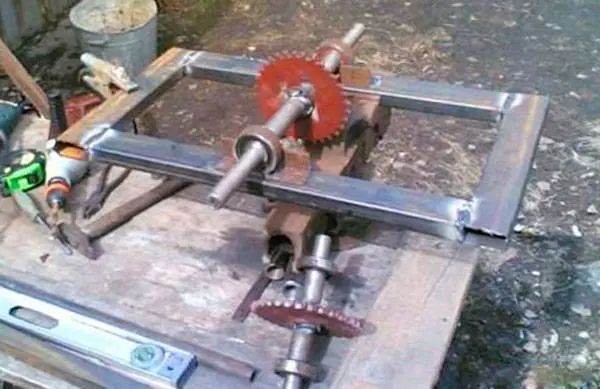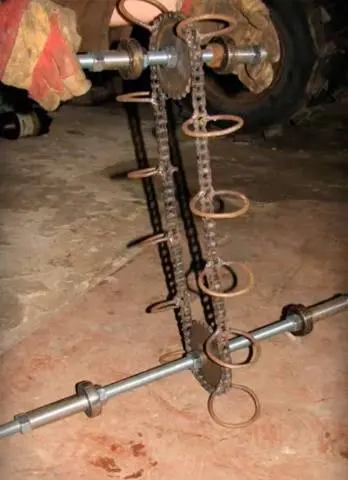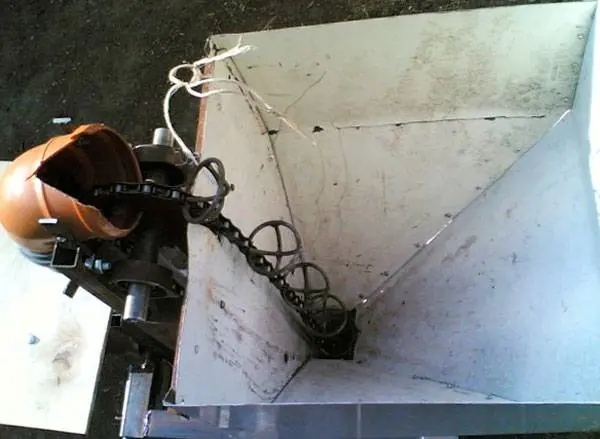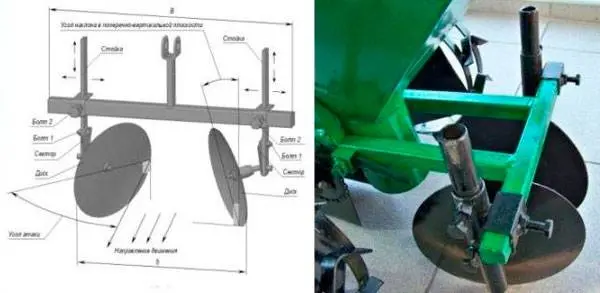Contents
Planting potatoes is a rather laborious process. And if in a small garden you can handle it manually, then it is very difficult to plant a large area without the use of technology. The walk-behind tractor has now become an indispensable assistant to the gardener. But the unit itself provides only tractive power, and to perform any tasks, you also need to have a tow hitch. One of these mechanisms is a potato planter for a walk-behind tractor, which allows you to automate the planting process.
The device and operation of a potato planter
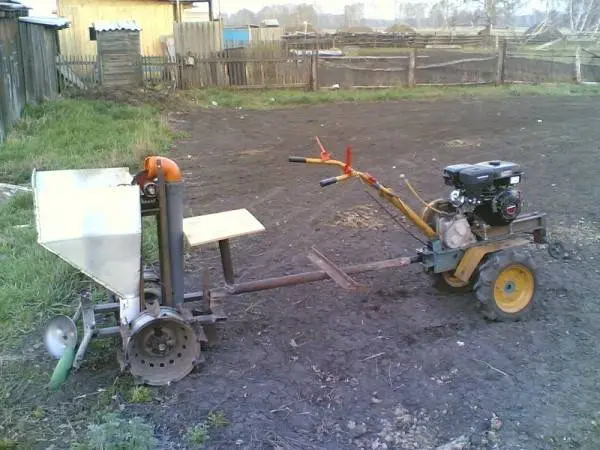
So, a potato planter is a hitch to a walk-behind tractor or a mini-tractor. While the machine is moving, the chain mechanism with bowls automatically picks up potato tubers from the hopper and feeds them into the holes. A plow is installed under the frame near the planter for the walk-behind tractor. He is responsible for cutting the furrow.
At the end of the planter frame, two discs are installed at an angle. After feeding the tuber, they fill the furrow with soil. In order for the potatoes to fall into the hole evenly, the bowls are attached to the chain mechanism at the same distance. The size of the hitch and the volume of the landing hopper are selected individually, taking into account the power of the walk-behind tractor or mini-tractor.
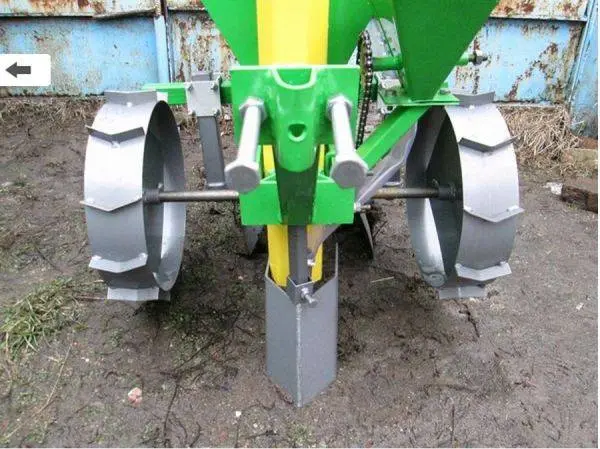
The design of a homemade potato planter consists of the following main parts:
- The frame is the basis of the hitch. It is welded from a shaped pipe. Why is this material used? The square section gives strength to the pipe, while keeping it fairly light. In addition to a flat profile wall, it is easier to attach potato planter parts than to a round pipe. All working units are fixed on the frame, and the bow is equipped with a device with which the planter is coupled to the walk-behind tractor.
- The hopper is a cone-shaped container for loading potatoes. The choice of this form is not accidental. In many photos, you can see homemade bins from a stainless steel tank of a washing machine. Not a bad option, but during planting there may be missed empty areas of the furrow. In the cone-shaped hopper, the potatoes constantly sink to the bottom, which allows the tubers to be captured by the bowls, even if they are left alone. The bottom of the washing machine tank is sloped, but not enough to provide a secure grip down to the last potato.
- The chain mechanism works like a conveyor. It is set in motion by an asterisk attached to the shaft of the wheels. A second sprocket is installed above the rear wall of the hopper for tensioning the mechanism. The conveyor is usually made of a bicycle or motorcycle chain. Bowls of wire are welded to its links at an equal distance.
- The plow is fixed under the frame and is positioned directly in front of the chain mechanism. He cuts a furrow before the potato falls out of the bowl.
- Angled at the rear of the frame, two discs form a harrow. They fall asleep tubers that have fallen into the hole.
That’s the whole potato planter device. Such a simple mechanism will allow you to quickly plant your garden using a walk-behind tractor.
Drawings of potato diggers
We invite you to look at the do-it-yourself drawings of the dimensions of a walk-behind potato planter, which will help in the further design of a trailing device.
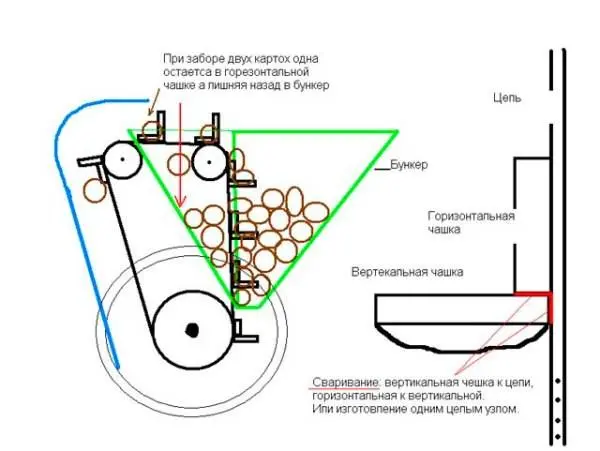
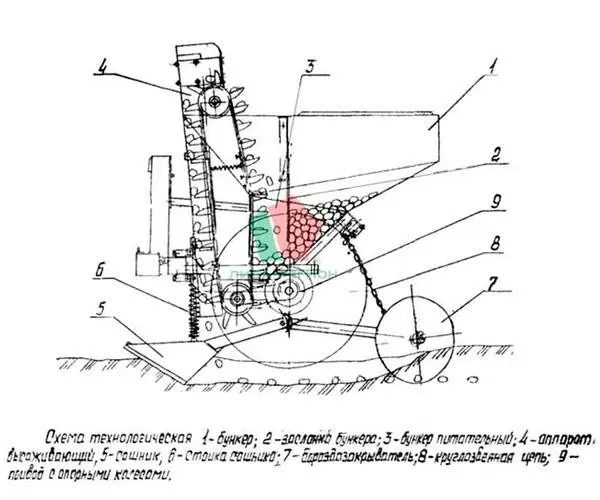

The following photo shows the calculation of a chain mechanism with sprockets.

Instructions for making a homemade potato planter
Let’s look at the procedure for carrying out work in the manufacture of a potato planter for a walk-behind tractor with our own hands:
- First you need to weld a solid frame from a profile pipe. A hitch is welded in front to connect to a walk-behind tractor, as well as two conveyor racks. At the back of the frame, fasteners for the discs are welded.
- Under the frame, that is, from its lower side, attachments are welded to fix the plow. The bearing races are also attached here, which will be mounted on the shaft with the drive sprocket.
- The assembly of the shaft begins with the installation of the sprocket. It can be fixed on the key by tightening the nuts on both sides. It’s easier to weld an asterisk, but this design will not be collapsible. If the teeth are broken, the sprocket will have to be cut off with a grinder or a cutter. Further, bearings are placed on the shaft, the structure is installed in the prepared cages. A wheel hub is attached to the ends of the shaft.To prevent the bearings with the shaft from coming out of the cages during the movement of the walk-behind tractor, bolt two stops from the metal corner to the frame.

- Now we start making bowls for grabbing potatoes from the bunker. For this, a ring with a diameter of 6 mm is bent from a steel wire with a cross section of 60 mm. The wire joint must be welded. From the bottom of the bowl, curved bridges are welded crosswise so that the small tuber does not fall through the ring.

- The number of bowls is calculated so that the tubers fall into the furrow every 25-30 cm. This is done empirically, since it all depends on the diameter of the stars and the length of the chain. The finished bowls are welded to the chain links at the same distance.

- On the front-welded frames, two conveyor posts are attached to the hubs and a shaft with a tensioning sprocket is installed, after which a chain is put on. To tighten it, the front conveyor legs can be made in two bolted parts. When lifting the upper parts of the struts, the chain will stretch, after which you need to fix them with bolts.
- Now we start making the bunker. The chain will get in the way, so it will be temporarily removed. The hopper is cut out of sheet steel. You should get a cone-shaped quadrangular container as in the photo. Please note that one of the walls on the side of the chain is not made at an angle, but strictly vertical. This design allows the conveyor to perform better.
- When the hopper is ready, put the chain in place. Now there is a fine adjustment of the mechanism. First, the chain is pulled, after which, while scrolling it, they look so that the conveyor does not cling to the edges of the container. When the optimal point for the location of the hopper is found, it is rigidly fixed.

- A chute must be installed behind the hopper. It will guide the falling potatoes from the conveyor bowl straight into the hole. The gutter can be made of tin or PVC sewer pipe with a diameter of 110 mm.
- Finally, the discs are attached to the rear of the frame. It is imperative to make a mechanism that allows you to change the angle of their inclination and rotation.

On this, the potato planter for the walk-behind tractor is ready. You can install drive wheels and try to ride it around the garden.
Potato digger seat
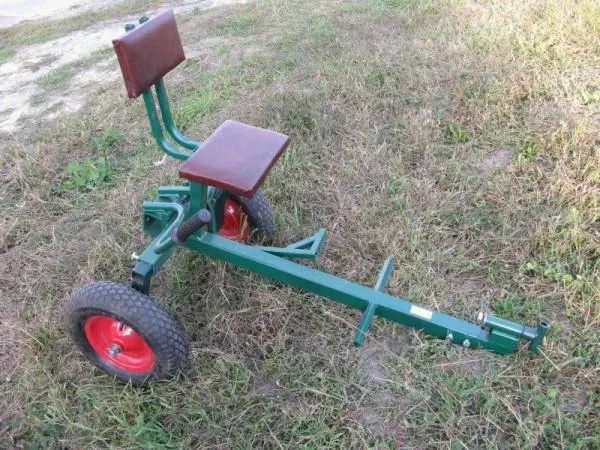
Walking behind a walk-behind tractor across a large field is very tiring. Resourceful owners of motoblocks improve potato diggers so that they can sit on them. To do this, make an elongated frame, and to it are welded from the profile of the rack with jumpers, which form the seat. Of course, it will be more convenient to lean on the back, but you can do without it.
Wheel design features
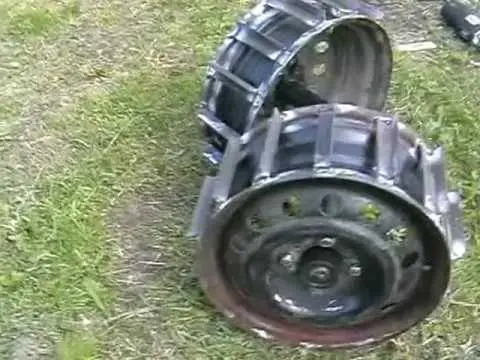
Ordinary wheels will not work for a potato planter. You need to take metal discs and weld lugs on them. There are many options. For example, you can simply weld pieces of a steel angle across, bend squares from a plate, weld spikes from rods, etc.
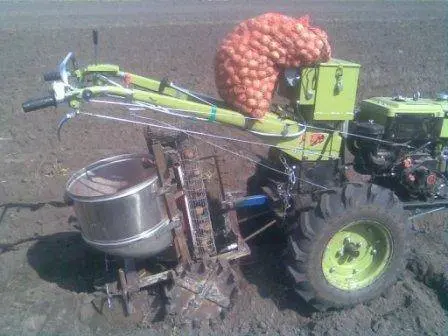
In the video, a homemade potato planter:
Without the skills of working with metal, it is difficult to make a potato planter on your own. But if the hands grow from the right place, a home-made design will significantly save the home budget.










